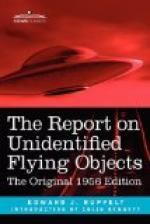As he watched, the object, whatever it was (by now he no longer thought that it was a parachute), began to gradually climb, so he started to climb, he said, staying above and off to the right of the object. When the UFO started to make a left turn, he followed and tried to cut inside, but he overshot and passed over it. It continued to turn and gain speed, so he dropped the nose of the TBM, put on more power, and pulled in behind the object, which was now level with him. In a matter of seconds the UFO made a 180-degree turn and started to make a big swing around the northern edge of Mitchel AFB. The pilot tried to follow, but the UFO had begun to accelerate rapidly, and since a TBM leaves much to be desired on the speed end, he was getting farther and farther behind. But he did try to follow it as long as he could. As he made a wide turn around the northern edge of the airfield he saw that the UFO was now turning south. He racked the TBM up into a tight left turn to follow, but in a few seconds the UFO had disappeared. When he last saw it, it had crossed the Long Island coast line near Freeport and it was heading out to sea.
When he finished his account of the chase, I asked the commander some specific questions about the UFO. He said that just after he’d decided that the UFO was not a parachute it appeared to be at an altitude of about 200 to 300 feet over a residential section. From the time it took it to cover a city block, he’d estimated that it was traveling about 300 miles an hour. Even when he pulled in behind the object and got a good look, it still looked like a parachute canopy— dome-shaped—white—and it had a dark undersurface. It had been in sight two and a half minutes.
He had called the control tower at Mitchel during the chase, he told me, but only to ask if any balloons had been launched. He thought that he might be seeing a balloon. The tower had told him that there was a balloon in the area.
Then the commander took out an aeronautical chart and drew in his flight path and the apparent path of the UFO for me. I think that he drew it accurately because he had been continually watching landmarks as he’d chased the UFO and was very careful as he drew the sketches on the map.
I checked with the weather detachment at Mitchel and they said that they had released a balloon. They had released it at nine-fifty and from a point southeast of the airfield. I got a plot of its path. Just as in the Long Beach Incident, where the six F-86’s tried to intercept the UFO, the balloon was almost exactly in line with the spot where the UFO was first seen, but then any proof you might attempt falls apart. If the pilot knew where he was, and had plotted his flight path even semi-accurately, he was never over the balloon. Yet he was over the UFO. He came within less than 2,000 feet of the UFO when he passed over it; yet he couldn’t recognize it as a balloon even though he thought it might be a balloon since the tower had just told him that there was one in the area. He said that he followed the UFO around the north edge of the airfield. Yet the balloon, after it was launched southeast of the field, continued on a southeast course and never passed north of the airfield.




